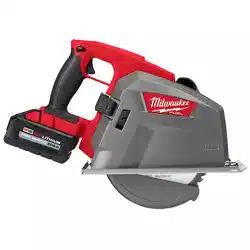Loading ...
Loading ...
Loading ...

7
OPERATION
WARNING
To reduce the risk of injury, always
wear proper eye protection marked
to comply with ANSI Z87.1.
When working in dusty situations, wear appro-
priate respiratory protection or use an OSHA
compliant dust extraction solution.
To reduce the risk of injury, everyone in the work
area should wear safety goggles or glasses
with side shields. Remove battery pack from
the tool before changing accessories or making
adjustments.
Keep hands away from the blade and other mov-
ing parts.
Always remove battery pack before changing
or removing accessories. Only use accessories
specically recommended for this tool. Others
may be hazardous.
Kickback causes and related warnings
-Kickback is a sudden reaction to a pinched, jammed
or misaligned saw blade, causing an uncontrolled
saw to lift up and out of the workpiece toward the
operator;
-When the blade is pinched or jammed tightly by
the kerf closing down, the blade stalls and the mo-
tor reaction drives the unit rapidly back toward the
operator;
- If the blade becomes twisted or misaligned in the
cut, the teeth at the back edge of the blade can dig
into the top surface of the workpiece causing the
blade to climb out of the kerf and jump back toward
the operator.
Kickback is the result of saw misuse and/or incor-
rect operating procedures or conditions and can be
avoided by taking proper precautions as given below:
• Maintain a rm grip with both hands on the saw
and position your arms to resist kickback forces.
Position your body to either side of the blade,
but not in line with the blade. Kickback could
cause the saw to jump backwards, but kickback
forces can be controlled by the operator, if proper
precautions are taken.
• When blade is binding, or when interrupting a
cut for any reason, release the trigger and hold
the saw motionless in the material until the
blade comes to a complete stop. Never attempt
to remove the saw from the work or pull the saw
backward while the blade is in motion or kick-
back may occur. Investigate and take corrective
actions to eliminate the cause of blade binding.
• When restarting a saw in the workpiece, centre
the saw blade in the kerf so that saw teeth are
not engaged into the material. If a saw blade is
binding, it may walk up or kickback from the work-
piece as the saw is restarted.
• Support large panels to minimise the risk of
blade pinching and kickback. Large panels tend
to sag under their own weight. Supports must be
placed under the panel on both sides, near the line
of cut and near the edge of the panel.
• Do not use dull or damaged blades. Unsharpened
or improperly set blades produce narrow kerf caus-
ing excessive friction, blade binding and kickback.
• Blade depth and bevel adjusting locking levers
must be tight and secure before making cut. If
blade adjustment shifts while cutting, it may cause
binding and kickback.
• Use extra caution when sawing into existing
walls or other blind areas. The protruding blade
may cut objects that can cause kickback.
• Adjust the cutting depth to the thickness of the
workpiece. Less than a full tooth of the blade
teeth, or less than 1/4" of the blade, should
be visible below the workpiece. The less blade
exposed, the less chance of binding and kickback.
Before cutting, be sure depth and bevel adjustments
are tight.
• Stay alert. Any distraction can cause twisting or
binding. Repetitive cuts may lull the user into care-
less movements.
General Operation
Always clamp the workpiece securely on a saw horse
or bench. See “APPLICATIONS” for the correct way
to support your work in dierent situations.
1. Draw a cutting line. Place the front of the shoe on
the edge of the workpiece without making blade
contact. Hold the handle with one hand and the
front handle with the other.
2. Line up the sight line with your cutting line. Position
your arms and body to resist kickback.
3. To start the saw, push the lock-o button down
while pulling the trigger. Allow the motor to reach
full speed before beginning cut.
4. While cutting, keep the shoe flat against the
workpiece and maintain a rm grip. Do not force
the saw through the workpiece. Forcing a saw can
cause kickback.
5. Use a moderate, continuous pressure to make the
cut while following the cut line through sight line. If
the wheel is pushed too hard into the workpiece,
the load indicator light will turn on. If this occurs,
reduce the pressure of the wheel into the work-
piece until the load indicator light turns o.
6. If making a partial cut, restarting in mid-cut or
correcting direction, allow the blade to come to
a complete stop. To resume cutting, center the
blade in the kerf, back the saw away from cutting
edge a few inches, push the lock-o button down
while pulling the trigger and re-enter the cut slowly.
7. If the saw binds and stalls, maintain a rm grip
and release the trigger immediately. Hold the saw
motionless in the workpiece until the blade comes
to a complete stop.
8. After nishing a cut, be sure the lower guard closes
and the blade comes to a complete stop before
setting the saw down.
Loading ...
Loading ...
Loading ...
